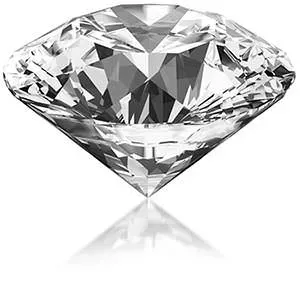 The German geologist and mineralogist Friedrich Mohs created the Mohs hardness scale in 1812. The Mohs hardness scale is a qualitative scale of hardness ranging from the numbers 1-10, 1 being the softest and 10 being the hardest. These numbers characterizes the scratch resistance of minerals by using harder materials to scratch softer materials, thus figuring out how hard each minerals is based on which specimen is left with a scratch. When reading about a gemstone, you will continually see its rating on Mohs hardness scale. This article will explain how exactly the scale works.
The German geologist and mineralogist Friedrich Mohs created the Mohs hardness scale in 1812. The Mohs hardness scale is a qualitative scale of hardness ranging from the numbers 1-10, 1 being the softest and 10 being the hardest. These numbers characterizes the scratch resistance of minerals by using harder materials to scratch softer materials, thus figuring out how hard each minerals is based on which specimen is left with a scratch. When reading about a gemstone, you will continually see its rating on Mohs hardness scale. This article will explain how exactly the scale works.
 Mohs chose ten minerals of very different hardness to compare, ranging from a very soft mineral (talc) to a very hard mineral (
Mohs chose ten minerals of very different hardness to compare, ranging from a very soft mineral (talc) to a very hard mineral (![]() diamond). While a diamond is not actually the hardest substance known, materials that are harder than a diamond are extremely rare. Wurtzite, boron, nitride, and lonsdaleite for example, are some specimen that can be harder than diamond. In terms of softness, talc is used as the softest material; however again, materials do exist that are in fact softer, though very rare. These include caesium, rubidium, lithium, sodium and potassium.
diamond). While a diamond is not actually the hardest substance known, materials that are harder than a diamond are extremely rare. Wurtzite, boron, nitride, and lonsdaleite for example, are some specimen that can be harder than diamond. In terms of softness, talc is used as the softest material; however again, materials do exist that are in fact softer, though very rare. These include caesium, rubidium, lithium, sodium and potassium.
 Mohs hardness scale works by placing a sharp point of one mineral on an unmarked surface of another mineral and trying to produce a scratch in order to see which mineral actually winds up with a scratch, therefore determining its hardness. By determining the hardness of a mineral, we can make decisions about the ways in which it can be used and worn.
Mohs hardness scale works by placing a sharp point of one mineral on an unmarked surface of another mineral and trying to produce a scratch in order to see which mineral actually winds up with a scratch, therefore determining its hardness. By determining the hardness of a mineral, we can make decisions about the ways in which it can be used and worn.
 Even though the Mohs scale may seem simple, and not exactly precise, it is very helpful for field geologists, who use the scale to roughly identify minerals using these scratch kits.
Even though the Mohs scale may seem simple, and not exactly precise, it is very helpful for field geologists, who use the scale to roughly identify minerals using these scratch kits.
Here is an example of common objects and their rating on the Mohs Hardness scale:
 The fact that a knife rates a 5 to 6.5 makes the knife a common object for geologists to carry with them in the field- one scratch on a specimen will determine whether or not that specimen is harder or softer than a 5 to 6.5 if it leaves a mark. Confirming the hardness of the exact knife to be used before going out on the field is a way for the test to be more accurate.
The fact that a knife rates a 5 to 6.5 makes the knife a common object for geologists to carry with them in the field- one scratch on a specimen will determine whether or not that specimen is harder or softer than a 5 to 6.5 if it leaves a mark. Confirming the hardness of the exact knife to be used before going out on the field is a way for the test to be more accurate.
Here are some examples of the hardness of certain minerals, according to Mohs scale:
 In determining what exactly a mineral is on the field, having a list of minerals in order of their hardness can help determine what mineral a geologist may be looking at after testing it.
In determining what exactly a mineral is on the field, having a list of minerals in order of their hardness can help determine what mineral a geologist may be looking at after testing it.
 Since the Mohs Scale was developed, many other hardness tests have been invented. These include tests by Brinell, Knoop, Rockwell, Shore and Vickers. Each of these tests uses a small "indenter"" that is applied to the material being tested with a carefully measured amount of force. Then, the size or depth of the indentation coupled with the amount of force is calculated into a hardness value. The Mohs scale however, is the most universal scale, and the one all jewelers reference today."
Since the Mohs Scale was developed, many other hardness tests have been invented. These include tests by Brinell, Knoop, Rockwell, Shore and Vickers. Each of these tests uses a small "indenter"" that is applied to the material being tested with a carefully measured amount of force. Then, the size or depth of the indentation coupled with the amount of force is calculated into a hardness value. The Mohs scale however, is the most universal scale, and the one all jewelers reference today."